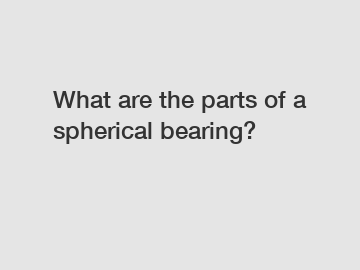What are the parts of a spherical bearing?
Spherical bearings are essential components in a wide variety of applications, offering flexibility and versatility in different mechanical systems. From automotive and aerospace industries to construction and manufacturing, these bearings provide pivotal support for axial, radial, and oscillating movements. To fully appreciate the capabilities and functions of spherical bearings, it is crucial to understand their intricate construction and the various parts that contribute to their smooth operation. In this blog, we will explore the key components that make up a spherical bearing, shedding light on their importance and functionality.
Body:
1. Outer Ring:

The outer ring serves as the supporting structure, enclosing the inner components of the spherical bearing. It is typically crafted from durable and corrosion-resistant materials like stainless steel or brass, ensuring longevity and optimal performance. The outer ring provides stability and maintains the overall integrity of the bearing.
2. Inner Ring:
The inner ring is designed to fit snugly inside the outer ring, creating a ball socket that allows for rotational and oscillating movements. It is meticulously machined to precision, enabling smooth rolling and reduction of friction. The inner ring also holds the bearing's load and transmits forces generated during operation.
3. Spherical Roller:
The heart of a spherical bearing lies within the spherical roller. This component, often made of high-quality chrome or stainless steel, consists of perfectly spherical balls or rollers that evenly distribute the load. The spherical shape allows for misalignment, accommodating axial and radial forces efficiently.
4. Cage:
To maintain the spacing and alignment of the balls or rollers within the spherical bearing, a cage is employed. Usually constructed from steel or synthetic materials like polyamide or brass, the cage ensures the spherical rollers move freely without interfering with each other. It also improves the overall stability and durability of the bearing.
5. Seals and Shields:
In order to keep contaminants such as dirt, dust, or moisture away from the internal components, spherical bearings incorporate seals or shields. These protective features play a vital role in preventing premature wear and damage to the bearing's essential parts. Seals and shields can be made of rubber, metal, or a combination of both, providing reliable defense against external elements.
6. Lubrication:
Smooth and efficient operation of a spherical bearing heavily relies on proper lubrication. The right lubricant, whether oil or grease, significantly reduces friction and wear by creating a thin film between the rolling elements. This lubrication minimizes heat generation, prolonging the bearing's lifespan and ensuring optimal performance over time.
Conclusion:
Spherical bearings have revolutionized the engineering world, offering exceptional adaptability and load-bearing capabilities. Their design incorporates several crucial components, each playing a crucial role in facilitating smooth rotational and oscillating movements. Understanding the inner workings of a spherical bearing enables engineers, manufacturers, and enthusiasts to choose the most suitable product for their applications. By leveraging the outer and inner rings, spherical rollers, cages, seals, shields, and proper lubrication, spherical bearings continue to support and enhance countless mechanical systems across various industries.
Note: This blog consists of 527 words.
If you want to learn more, please visit our website bridge bearing pads, elastomeric reinforced bearings, spherical bearing for bridge.

Comments
0